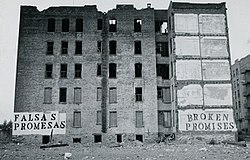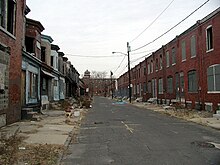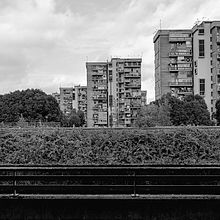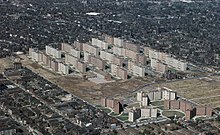Michenzani, Zanzibar
Urban decay (also known as urban rot and urban blight) is the sociological process by which a previously functioning city, or part of a city, falls into disrepair and decrepitude. It may feature deindustrialization, depopulation or deurbanization, economic restructuring, abandoned buildings and infrastructure, high local unemployment, fragmented families, political disenfranchisement, crime, and a desolate cityscape, known as greyfield or urban prairie.
Since the 1970s and 1980s, urban decay has been associated with Western cities, especially in North America and parts of Europe (mostly the United Kingdom and France). Since then, major structural changes in global economies, transportation, and government policy created the economic and then the social conditions resulting in urban decay.
The effects counter the development of most of Europe and North
America; on other continents, urban decay is manifested in the
peripheral slums at the outskirts of a metropolis, while the city center and the inner city retain high real estate
values and sustain a steadily increasing populace. In contrast, North
American and British cities often experience population flights to the suburbs and exurb commuter towns; often in the form of white flight.
Another characteristic of urban decay is blight—the visual,
psychological, and physical effects of living among empty lots,
buildings and condemned houses.
Urban decay has no single cause; it results from combinations of inter-related socio-economic conditions—including the city's urban planning decisions, tight rent control, the poverty of the local populace, the construction of freeway roads and rail road lines that bypass—or run through—the area, depopulation by suburbanization of peripheral lands, real estate neighborhood redlining, and immigration restrictions.
History
During the Industrial Revolution,
from the late eighteenth century to the early nineteenth century, rural
people moved from the country to the cities for employment in
manufacturing industry, thus causing the urban population boom. However,
subsequent economic change left many cities economically vulnerable.
Studies such as the Urban Task Force (DETR 1999), the Urban White Paper
(DETR 2000), and a study of Scottish cities (2003) posit that areas
suffering industrial decline—high unemployment, poverty, and a decaying
physical environment (sometimes including contaminated land and obsolete
infrastructure)—prove "highly resistant to improvement".
Changes in means of transport, from the public to the
private—specifically, the private motor car—eliminated some of the
cities' public transport service advantages, e.g., fixed-route buses and
trains. In particular, at the end of World War II, many political
decisions favored suburban development and encouraged suburbanization, by drawing city taxes from the cities to build new infrastructure for towns.
The manufacturing sector has been a base for the prosperity of
major cities. When the industries have relocated outside of cities, some
have experienced population loss with associated urban decay, and even riots.
Cut backs on police and fire services may result, while lobbying for
government funded housing may increase. Increased city taxes encourage
residents to move out.
Rent control
Rent controls are often enacted due to public pressure and complaints
regarding the cost of living. Proponents of rent controls argue that
rent controls combat inflation, stabilize the economic characteristics
of a city's population, prevent rent gouging, and improve the quality of
housing.
Capitalist economists have documented that rent control affects the
supply and demand relationship in housing markets which can contribute
to urban blight and does not provide the benefits its proponents
advocate.
Rent control contributes to urban blight by reducing new construction
and investment in housing and deincentivizing maintenance.
If a landlord's costs to perform maintenance consume too large a
proportion of profit, that is revenue minus costs, from rent, the
landlord will feel pressure to drastically reduce or eliminate
maintenance entirely. This effect has been observed in New York City, a
2009 study by a lobbying firm found 29% of rent-controlled buildings
were categorized as either deteriorated or dilapidated in contrast with
8% of non-rent-controlled housing.
Countries
United States
Urban decay in the United States: Presidents Jimmy Carter (5 October 1976) and Ronald Reagan (5 August 1980) campaigned before this ruin on Charlotte Street in the South Bronx, New York City.
Much of the city of Camden, New Jersey suffers from urban decay.
Historically in the United States,
the white middle class gradually left the cities for suburban areas
because of higher crime rates and perceived danger caused by African-American migration north toward cities after World War I (the Great Migration)—the so-called "white flight" phenomenon.
Some historians differentiate between the first Great Migration
(1910–1930), numbering about 1.6 million Black migrants who left mostly
Southern rural areas to migrate to northern and midwestern industrial
cities, and, after a lull during the Great Depression, a Second Great Migration (1940–1970), in which 5 million or more African-Americans moved, including many to California and various western cities.
Between 1910 and 1970, Blacks moved from 14 states of the South, especially Alabama, Louisiana, Mississippi and Texas
to the other three cultural (and census-designated) regions of the
United States. More townspeople with urban skills moved during the
second migration.
By the end of the Second Great Migration, African Americans had become
an urbanized population. More than 80 percent lived in cities. A
majority of 53 percent remained in the South, while 40 percent lived in
the North and 7 percent in the West.
From the 1930s until 1977, African-Americans seeking borrowed
capital for housing and businesses were discriminated against via the
federal-government–legislated discriminatory lending practices for the Federal Housing Administration (FHA) via redlining. In 1977, the US Congress passed the Community Reinvestment Act, designed to encourage commercial banks and savings associations to help meet the needs of borrowers in all segments of their communities, including low- and moderate-income neighborhoods.
Later urban centers were drained further through the advent of
mass car ownership, the marketing of suburbia as a location to move to,
and the building of the Interstate Highway System. In North America this shift manifested itself in strip malls,
suburban retail and employment centers, and very low-density housing
estates. Large areas of many northern cities in the United States
experienced population decreases and a degradation of urban areas.
Inner-city property values declined and economically
disadvantaged populations moved in. In the U.S., the new inner-city poor
were often African-Americans that migrated from the South in the 1920s
and 1930s. As they moved into traditional white neighborhoods, ethnic
frictions served to accelerate flight to the suburbs.
United Kingdom
Britain experienced severe urban decay in the 1970s and 1980s exemplified by The Specials' 1981 hit single "Ghost Town".
Major cities like Glasgow, the towns of the South Wales valleys, and some of the major industrial cities like Manchester, Liverpool, Newcastle, and East London, all experienced population decreases, with large areas of 19th-century housing experiencing market price collapse. Some seaside resort towns have also experienced urban decay towards the end of the 20th century, due to the popularity of Package holidays to the continent.
France
Large French
cities are often surrounded by areas of urban decay. While city centers
tend to be occupied mainly by upper-class residents, cities are often
surrounded by public housing developments, with many tenants being of North African origin (from former French colonies Morocco, Algeria and Tunisia), and recent immigrants.
From the 50s to the 70s, publicly funded housing projects
resulted in large areas of mid to high-rise buildings. These modern
"grands ensembles" were welcomed at the time, as they replaced shanty
towns and raised living standards, but these areas were heavily affected
by economic depression in the 80s.
The banlieues of large cities like Lyon,
especially the northern Parisian banlieues, are severely criticized and
forgotten by the country's territorial spatial planning administration.
They have been ostracised ever since the French Commune
government of 1871, considered as "lawless" or "outside the law", even
"outside the Republic", as opposed to "deep France" or "authentic
France", which is associated with the countryside.
In November 2005, the French suburbs were the scene of severe riots
sparked by the accidental electrocution of two teenagers in the
northern suburbs of Paris, and fueled in part by the substandard living
conditions in these areas. Many deprived suburbs of French cities were
suddenly the scenes of clashes between youngsters and the police, with
violence and numerous car burnings resulting in huge media coverage.
Today the situation remains generally unchanged; however, there
is a level of disparity. Some areas are experiencing increased drug
trafficking, while some northern suburbs of Paris and areas like Vaulx-en-Velin are undergoing refurbishment and re-development.
Some previously mono-industrial
towns in France are experiencing increasing crime, decay, and
decreasing population. The issue remains a divisive issue in French
public politics.
Italy
Council houses in Scampia, Naples
In Italy, one of the most well known case of urban decay is represented by the Vele di Scampia, a large public housing estate built between 1962 and 1975 in the Scampia neighbourhood of Naples.
The idea behind the project was to provide a huge urban housing
project, where hundreds of families could socialise and create a
community. The design included a public transportation rail station, and
a large park area between the two buildings. The planners wanted to
create a small city model with large parks, playing fields, and other
facilities.
However, various events led to tremendous urban decay inside this project and in the surrounding areas. It all started with the 1980 earthquake in Irpinia, which led many families, left homeless, to squat the flats inside the Vele. Things were made worse by the total lack of police presence, resulting in a deep bundling of the Camorra inside the area, which now controls drug trafficking, illegal street racing, gangs, and fencing operations.
South Africa
In South Africa, the most prominent urban decay case is Hillbrow, an inner city neighborhood of Johannesburg. A formerly white neighborhood, at the end of apartheid in 1994, most of its residents fled to Cape Town and suburbs leaving their properties behind. Businesses that operated in the area also moved to suburbs.
Occupied by mainly black low-income classes and immigrants, the
proliferation of crime, drugs, illegal businesses and decay of
properties became prevalent.
Policy responses to urban decay
Pruitt–Igoe public housing, St. Louis, Missouri. In the 1950s, this urban renewal project was built; it failed and was razed in the 1970s.
The main responses to urban decay have been through positive public
intervention and policy, through a plethora of initiatives, funding
streams, and agencies, using the principles of New Urbanism (or through Urban Renaissance, its UK/European equivalent). Gentrification has also had a significant effect, and remains the primary means of a natural remedy.
United States
In the United States, early government policies included "urban renewal" and building of large-scale housing projects
for the poor. Urban renewal demolished entire neighborhoods in many
inner cities; in many ways, it was a cause of urban decay rather than a
remedy. These government efforts are now thought by many to have been misguided.
For multiple reasons, some cities have rebounded from these policy mistakes. Meanwhile, some of the inner suburbs built in the 1950s and 60s are beginning the process of decay, as those who are living in the inner city are pushed out due to gentrification.
Europe
In Western Europe, where undeveloped land is scarce and urban areas are generally recognised as the drivers of the new information and service economies, urban renewal
has become an industry in itself, with hundreds of agencies and
charities set up to tackle the issue. European cities have the benefit
of historical organic development patterns already concurrent to the New
Urbanist model, and although derelict, most cities have attractive
historical quarters and buildings ripe for redevelopment.
In the inner-city estates and suburban cités, the solution is
often more drastic, with 1960s and 70s state housing projects being
totally demolished and rebuilt in a more traditional European urban
style, with a mix of housing types, sizes, prices, and tenures, as well
as a mix of other uses such as retail or commercial. One of the best examples of this is in Hulme, Manchester, which was cleared of 19th-century housing in the 1950s to make way for a large estate of high-rise flats. During the 1990s, it was cleared again to make way for new development built along new urbanist lines.





